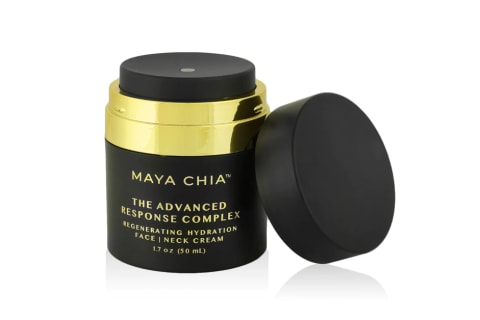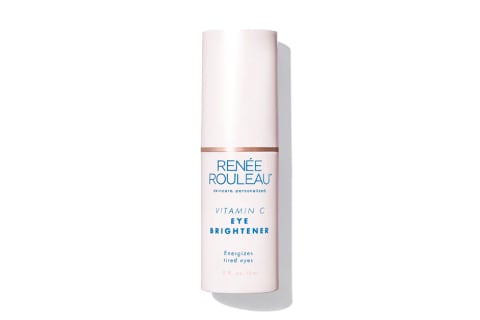Advertisement
Crepey Skin: Causes, Treatments & The Best Products To Treat It With


Imagine a sheet of crepe paper—that thin, wispy material commonly used to make streamers or fold into faux flowers. Sure, it's great for all your DIY craft projects, but it's not so fun when your skin resembles the same fragile texture.
But crepiness isn't as inevitable as you may think; here's everything you need to know about what causes crepey skin, plus how to prevent it and enjoy firm-looking skin for as long as possible.
What is crepey skin?

"Skin 'crepiness' is commonly used to describe aging skin that has lost elasticity, appearing thinner and more fragile, often with wrinkles," explains board-certified dermatologist, dermatologic surgeon, and founder of Spectrum Skin and Laser Jeremy Brauer, M.D.
Crepey skin is a normal, common skin concern that affects people of any age (especially if you already have thin skin); it tends to show up more prominently as you get older. This is due to the natural collagen loss that happens with age, accumulated sun damage, and increased dryness of the skin. (We get into causes in a moment, so we'll elaborate there.)
As board-certified cosmetic dermatologist Divya Shokeen, M.D., FAAD, tells us, it's most often triggered by excessive sun exposure, especially if crepey skin starts to show up in your 20s or 30s. Shokeen notes crepey skin starting in your mid-20s is more often caused by notable tanning bed use or aggressive, unprotected sun exposure (i.e., regular sunbathing without SPF). All the more reason to practice safe sun!
Additionally, crepey skin can be traced back to weight gain and loss. "It can show up sooner if your weight has fluctuated significantly, like gaining or losing weight," adds board-certified dermatologist Purvisha Patel, M.D.
Where does crepey skin appear?
Crepey skin can appear almost anywhere on the body, especially if you naturally have thin skin. That being said, it's more common in the following places:
- Eyelids
- Back of the arms
- Inner thighs
- Décolletage
- Forearms
- Under-eyes
- Neck
- Back of the hands
Crepey skin causes
Skin is a multifaceted, complex organ—so when discussing various skin concerns, there's often no one singular cause. Instead, it's typically a mix of several:
- Natural collagen loss: "Collagen and elastic fibers in the skin are what provide skin with its resiliency—not only the ability to stretch but return to baseline afterward," Brauer says. "As we lose collagen and elastic fibers with age, environmental exposures, our skin's ability to return to baseline after stretching or trauma is reduced."
- Sun damage: "Over time, aggressive or excessive exposure to the sun breaks down elastin in your skin. Elastin usually has the ability to stretch and recoil, but with repeated sun damage it loses the ability to heal properly and so remains stretched. This laxity leads to the appearance of lax or crepey skin," Shokeen explains.
- Natural genetic predisposition to it: As mentioned earlier, anyone with naturally thinner skin is more prone to crepiness. Still, the preventive measures in the following section can help you delay the onset of that crepiness a bit.
- Lack of moisture: "Moisture retention or hydration is a very important component of healthy skin, and dry climate or other environmental factors that contribute to loss of hydration can result in increased crepiness," Brauer notes.
- Smoking: Brauer notes smoking as another factor that contributes to crepey skin. This can also result in hyperpigmentation (read: dark spots) on the face and the body.
- Diet: While there isn't a strict regimen of "bad" or good food for crepey skin, a diet rich in whole and natural foods supports overall skin health and collagen production. On the flip side, lacking leafy green vegetables and collagen-rich foods can accelerate the development of crepey skin. "Years of ingesting insufficient or poor-quality protein is also a major contributor," board-certified dermatologist Carl Thornfeldt, M.D., adds.
How to prevent crepey skin
So, no, you can't entirely prevent crepey skin from coming along at some point (and that's OK! It's normal for skin to change as we age). However, you can encourage tighter, more resilient skin should you feel insecure about crepey skin you already notice. Or if you just want to prevent accelerated skin aging, that's reason enough too (after all, taking care of your skin usually just amounts to healthy lifestyle habits).
Here are a few overarching prevention principles to keep in mind:
Wear SPF
As mentioned before, sun exposure is a huge contributor to collagen loss and crepey skin. While you shouldn't hide from the sun entirely (for the sake of living your life to the fullest), you should wear sunscreen every day—even when it's cloudy.
If you're in direct sunlight for more than two hours (on a long walk, at the beach, working outside, etc.), be sure to reapply your SPF. You should also utilize accessories such as hats, sunglasses, and clothing with UPF.
You'll need sunscreen you love to stay committed, so browse these mineral sunscreens for some curated A+ picks.
Consume proteins & vitamin C
We covered this above, but a gentle reminder: Consuming enough protein is essential for maintaining healthy, elastic skin.
The current Recommended Dietary Allowance (RDA) for protein is 0.8 gram of protein per kilogram of body weight per day (g/kg). For a 130-pound individual, that would be approximately 47 grams of protein per day, though many experts regard that as the absolute minimum and recommend a goal closer to 100 grams of protein per day.
In addition, up your vitamin C intake. While it's best known for its immune benefits, vitamin C is required for your body to produce collagen, aka a must-have for tighter skin.
Keep the skin barrier strong
"An intact skin barrier not only protects your body by preventing outside agents (i.e., bacteria) from getting in but also by preventing water from getting out, maintaining hydration and locking in moisture," explains Brauer. "When your skin barrier is compromised, there is a greater loss of water, resulting in decreased skin turgor, which ultimately leads to crepey skin."
Long story short: Be mindful of your skin barrier, and tend to it on a daily basis. Do so by prioritizing moisturizing ingredients like hyaluronic acid, ceramides, peptides, plant butters, and botanical oils. At the same time, protect your skin from overexfoliation and excessive sun exposure resulting in burn if you can. Here are the barrier-supporting best body lotions for crepey skin, in case you're curious—as well as the best neck creams, as that's a very common area for crepey skin.
How to treat crepey skin at home
Like many skin concerns, prevention is generally the best route for crepey skin. However, there are steps you can take to ease the wrinkling and sagging should you start to see it developing:
Hydrate your skin
First up, you must prioritize internal and external hydration. As board-certified dermatologist Hadley King, M.D., told us, "Moisturize, moisturize, moisturize—this can improve the appearance."
Here's why: "Trapping in water with moisturizers helps to decrease transepidermal water loss and prevents dry skin, hence, ease crepey skin," Patel notes. In essence, never skip your moisturizer, and add a hydrating serum and nourishing oil to your routine if you find your complexion running dry throughout the day.
Especially if you start using retinol and exfoliants (more details to come), your skin will crave moisture post-treatment, so get into the habit of moisturizing twice daily.
Brauer adds, "Drink at least eight cups of water per day (ideally, try to drink half your weight in pounds in ounces per day)." If you're not doing this already, give it a shot. You'll be shocked at how much better your skin looks in just a few days.
Try retinol or something similar
"Using retinoids regularly on the face, neck, body can help to build collagen and improve skin texture over time," Shokeen says. If you're new to retinol, start slowly with a gentle, low-potency formula, apply it over moisturizer at first, and work your way up to regular use.
Or, opt for ingredients like bakuchiol for similar benefits without the risk of extreme irritation. And yes, you can use retinol on your body as well—just look for a retinol body lotion or serum rather than mixing up your own.
Use antioxidant-rich topicals
"When you are exposed to certain environmental aggressors, oxygen can be converted into a free radical by using antioxidants like green tea, vitamin C, resveratrol, or turmeric (ferulic acid), and the skin can neutralize these free radicals and prevent damaging the elastin in your skin," Shokeen notes.
One easy addition: vitamin C serums. Or, if you're working on crepey skin in the body, look for lotions and creams rich in botanical extracts, butters, and oils to reap the protective benefits. For example, shea butter is high in vitamin E, and mango seed butter is high in vitamin C.
Exfoliate regularly
In order for your hydrating products and retinol to work, your skin will have to be cleared of excess dead skin cells. The way to do so: Exfoliate, but gently. See, crepey skin is especially sensitive because it's on the thinner and drier side, so you don't want to scrub your skin raw.
Instead, opt for once or twice a week at first, and consider working your way up to three times a week should you need it—but remember that over-exfoliation will only lead to irritation and more dryness (read: more crepey skin).
Not sure how to start? Here's an in-depth guide to exfoliation to help you out.
Take collagen-boosting peptides
You now know that crepey skin is directly linked to a lack of collagen in your skin, so why not tend to it at the source? Do this by ingesting hydrolyzed collagen peptides (the most well researched form as of now), and make it a daily habit.
Look for collagen supplements with additional skin-loving ingredients like hyaluronic acid, vitamins C or E, biotin, ceramides, etc., to ensure you get a bang for your buck. Start here with our favorite collagen supplements, all approved by a nutrition Ph.D.
In-office treatments
Now, if you've tried all of the above, and your crepey skin is persisting, you may want to consider an in-office treatment. Of course your dermatologist will match your unique skin with the right treatment, but just know these are a few of the options they might suggest:
- Lasers: "If you feel the damage has been done, lasers can create a long-lasting improvement and give your skin a second chance. Ablative or fractionated lasers like erbium and CO2 can be game changers for the neck and chest," Shokeen says.
- Chemical peels: Now, chemical peels are not for the faint of heart, as they take much more downtime than other procedures. However, they may be worth it, especially if you're dealing with crepey skin and treatment-resistant hyperpigmentation simultaneously.
- Microneedling: Another option is microneedling, where a device inserts tiny sterilized needles into the skin to encourage healing and spark collagen production. Many microneedling treatments now include radiofrequency as well, using red light to speed up healing and further stimulate collagen production, thus encouraging tighter skin.
Shop products for crepey skin
FAQ
How do you get rid of crepey skin?
To ease the appearance of crepey skin, focus on regular exfoliation, add retinol to your routine, and be sure to moisturize twice a day. Crepey skin tends to be dry, so incorporating rich creams and nourishing oils into your routine will help lock in hydration, improving the appearance of crepey skin now and encouraging tighter skin in the future.
What vitamin is lacking for crepey skin?
Crepey skin is linked to a decline in collagen production. "Collagen and elastic fibers in the skin are what provide skin with its resiliency—not only the ability to stretch but return to baseline afterward," Brauer says. "As we lose collagen and elastic fibers with age, environmental exposures, our skin's ability to return to baseline after stretching or trauma is reduced."
What is the No. 1 cream for crepey skin?
The mindbodygreen postbiotic body lotion is a great option for crepey skin because it's rich in hydrators like shea butter, aloe vera, and coconut oil but also contains antioxidants to protect the skin from free radicals. Here's a curated list of the best lotions for crepey skin if you want to browse further.
The takeaway
To prevent crepey, paper-thin skin, it's all about supporting your body's collagen and hydration levels. Be sure to add a collagen supplement to your diet, tend to your skin barrier, and stay out of the sun if you skipped SPF. To ease its appearance, consider adding a gentle retinol to your routine—here's everything you need to know about this hero ingredient.




